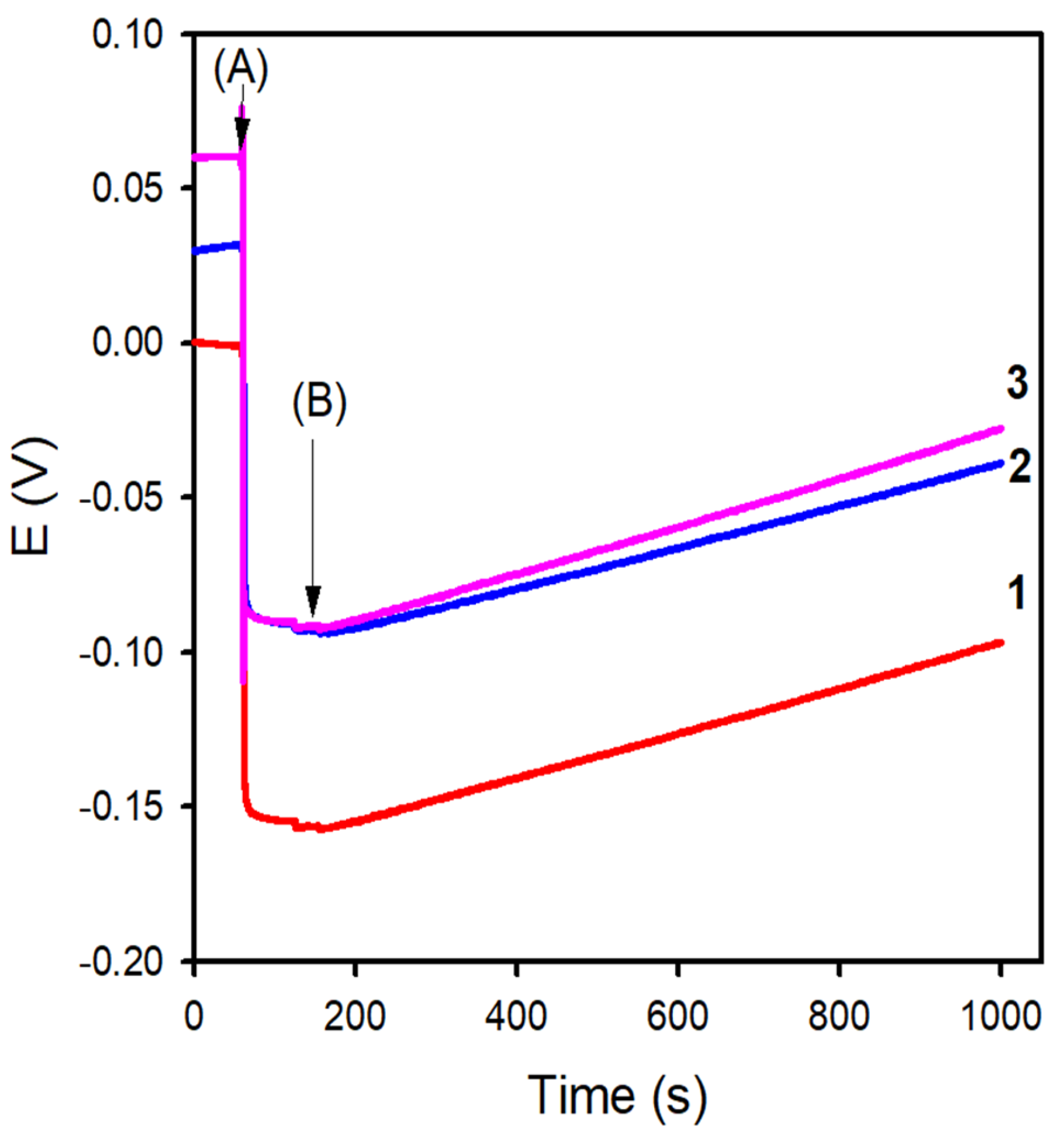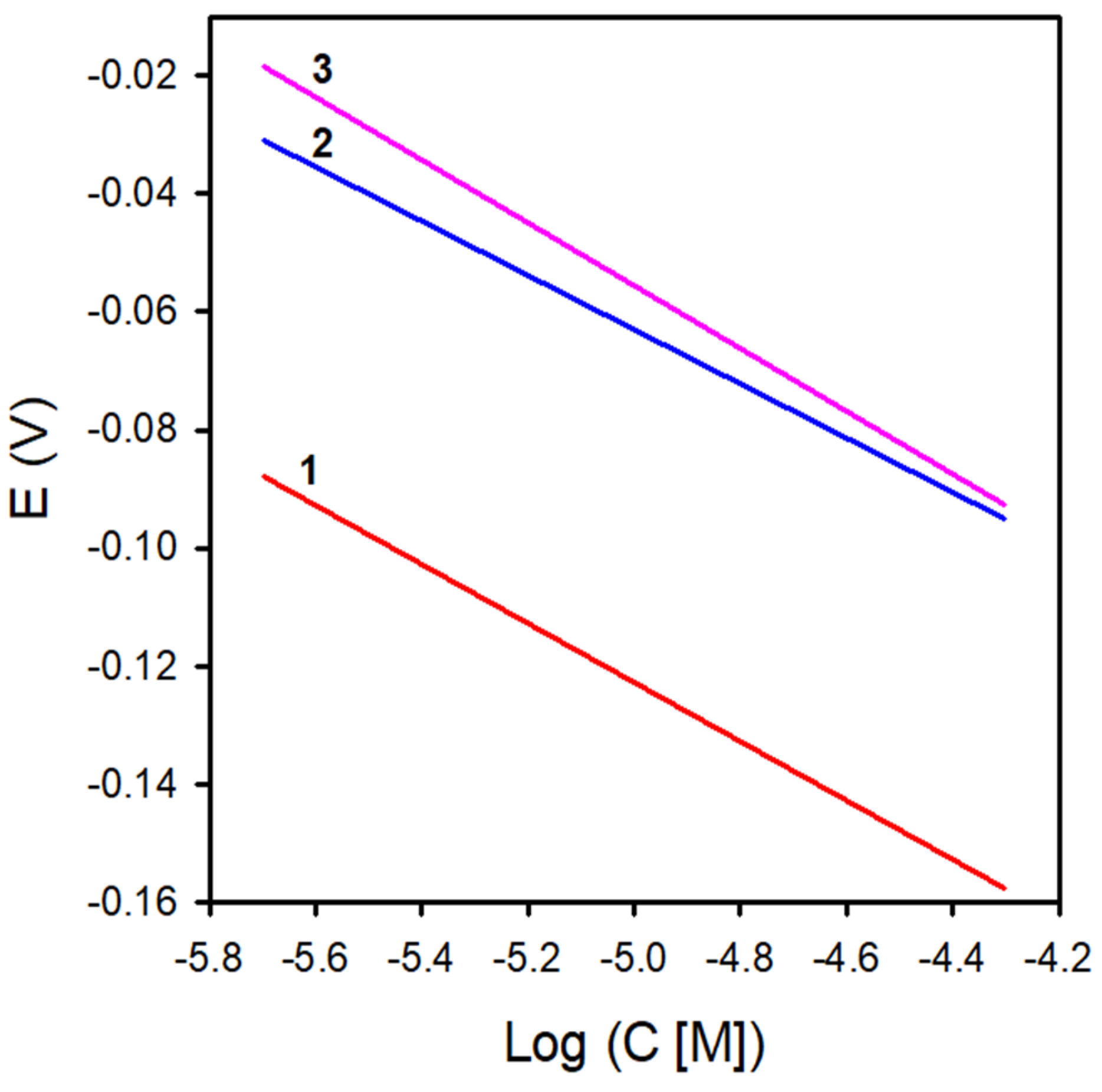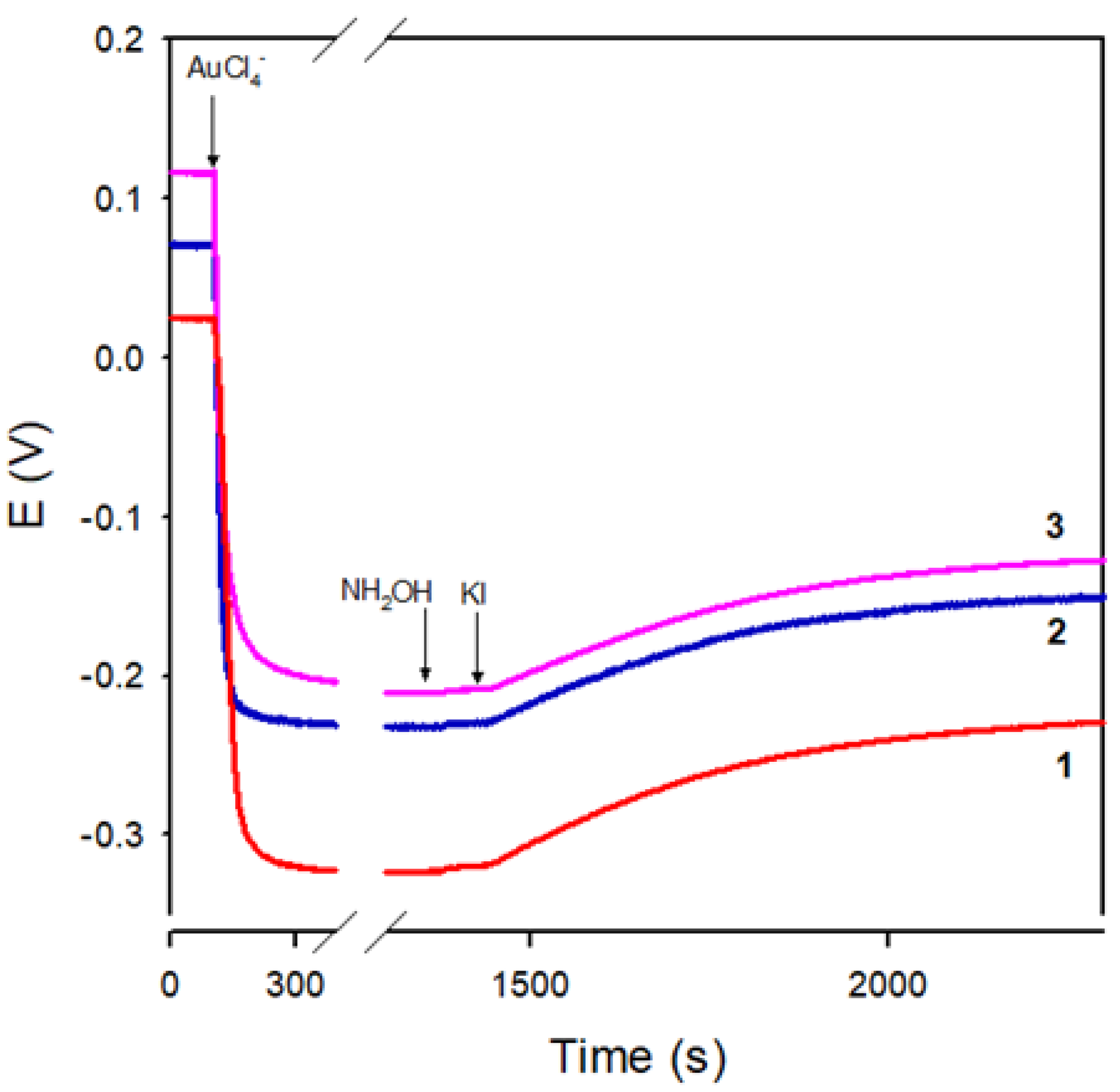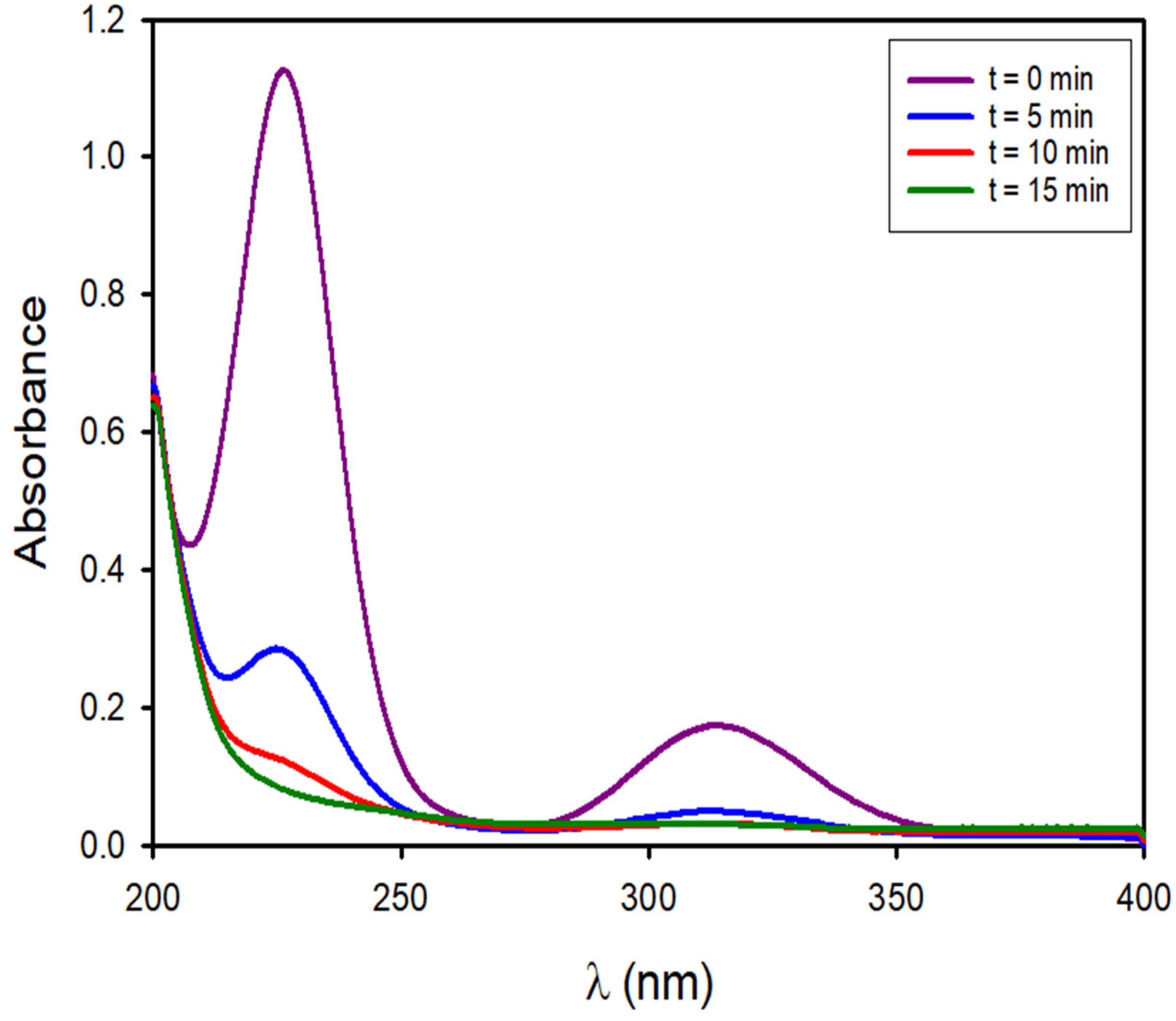Real-Time Potentiometric Monitoring of Tetrachloroaurate(III) with an Ion-Selective Electrode and Its Applications to HAuCl4 Iodide-Catalyzed Reduction by Hydroxylamine
Abstract
1. Introduction
2. Materials and Methods
2.1. Reagents and Solutions
2.2. Apparatus and Electrodes
2.3. Membrane Preparation
2.4. Calibration of the Tetrachloroaurate(III) Selective Electrodes
2.4.1. Calibration Procedure of Electrodes by Consecutive Tetrachloroaurate(III) Increments
2.4.2. Calibration Procedure by Continuous Dilution
2.4.3. Procedure for the Kinetic Potentiometric Monitoring of the Tetrachloroaurate(III) Reduction by Hydroxylamine Catalyzed by Iodide
3. Results
3.1. Potentiometric Response of the Electrodes towards Tetrachloroaurate(III)
3.2. Potentiometric Monitoring of Tetrachloroaurate Reduction by Hydroxylamine Catalysed by Iodide
3.3. Spectophotometric and DLS Measurements
3.4. Mechanism of the Studied Reaction
3.5. Further Prospects
4. Conclusions
Author Contributions
Funding
Institutional Review Board Statement
Informed Consent Statement
Data Availability Statement
Conflicts of Interest
References
- Mikhelson, K.N. Ion-Selective Electrodes; Springer: Berlin/Heidelberg, Germany, 2013; p. 5. [Google Scholar]
- Rousseau, I.; Atkinson, B. Acquisition and processing of data from a multiple pH-stat system monitoring enzyme kinetics (urea-urease). Analyst 1980, 105, 432–440. [Google Scholar] [CrossRef]
- Miksch, L.; Gutow, L.; Saborowski, R. PH-Stat titration: A rapid assay for enzymatic degradability of bio-based polymers. Polymers 2021, 13, 860. [Google Scholar] [CrossRef] [PubMed]
- Pentari, J.G.; Efstathiou, C.E.; Hadjiioannou, T.P. Kinetic determination of EDTA and citrate by the displacement of fluoride from Al3+F− complexes and use of a fluoride ion-selective electrode. Talanta 1991, 38, 295–301. [Google Scholar] [CrossRef] [PubMed]
- Koncki, R.; Ogończyk, D.; Głąb, S. Potentiometric assay for acid and alkaline phosphatase. Anal. Chim. Acta 2005, 538, 257–261. [Google Scholar] [CrossRef]
- Diamandis, E.P.; Koupparis, M.A.; Hadjiioannou, T.P. Kinetic potentiometric determination of creatinine in urine with a picrate-ion-selective electrode. Microchem. J. 1977, 22, 498–504. [Google Scholar] [CrossRef]
- Sánchez-Pedreño, C.; Ortuño, J.A.; Ros, A.L. Kinetic–potentiometric determination of iodide with an antimony(V) coated-wire ion-selective electrode. Analyst 1992, 117, 1619–1621. [Google Scholar] [CrossRef]
- Cuartero, M.; Ortuño, J.A.; García, M.S.; García-Cánovas, F. Assay of acetylcholinesterase activity by potentiometric monitoring of acetylcholine. Anal. Biochem. 2012, 421, 208–212. [Google Scholar] [CrossRef] [PubMed]
- Chumbimuni-Torres, K.Y.; Bakker, E.; Wang, J. Real-time probing of the growth dynamics of nanoparticles using potentiometric ion-selective electrodes. Electrochem. Commun. 2009, 11, 1964–1967. [Google Scholar] [CrossRef] [PubMed][Green Version]
- Carey, J.L.; Whitcomb, D.R.; Chen, S.; Penn, R.L.; Bühlmann, P. Potentiometric in situ monitoring of anions in the synthesis of copper and silver nanoparticles using the polyol process. ACS Nano 2015, 9, 12104–12114. [Google Scholar] [CrossRef] [PubMed]
- Darouich De Souza, C.; Ribeiro-Nogueira, B.; Rostelato, M.E.C.M. Review of the methodologies used in the synthesis of gold nanoparticles by chemical reduction. J. Alloys Compd. 2019, 798, 714–740. [Google Scholar] [CrossRef]
- Đurović, M.D.; Puchta, R.; Bugarčić, Ž.D.; van Eldik, R. Studies on the reactions of [] with different nucleophiles in aqueous solution. Dalton Trans. 2014, 43, 8620–8632. [Google Scholar] [CrossRef] [PubMed]
- Setyawati, M.I.; Xie, J.; Leong, D.T. Phage based green chemistry for gold ion reduction and gold retrieval. ACS Appl. Mater. Interfaces 2014, 6, 910–917. [Google Scholar] [CrossRef] [PubMed]
- Suwalsky, M.; González, R.; Villena, F.; Aguilar, L.F.; Sotomayor, C.P.; Bolognin, S.; Zatta, P. Structural effects of tetrachloroauric acid on cell membranes and molecular models. Coord. Chem. Rev. 2009, 253, 1599–1606. [Google Scholar] [CrossRef]
- Molina, A.; Ortuño, J.A.; Serna, C.; Torralba, E.; Gonzalez, J. Advances in the study of ion transfer at liquid membranes with two polarized interfaces by square wave voltammetry. Electroanalysis 2010, 22, 1634–1642. [Google Scholar] [CrossRef]
- Samec, Z. Electrochemistry at the interface between two immiscible electrolyte solutions. Pure Appl. Chem. 2004, 76, 2147–2180. [Google Scholar] [CrossRef]
- Wilke, S.; Zerihun, T. Standard Gibbs energies of ion transfer across the water|2-nitrophenyl octyl ether interface. J. Electroanal. Chem. 2001, 515, 52–60. [Google Scholar] [CrossRef]
- Horvai, G.; Tóth, K.; Pungor, E. A simple continuous method for calibration and measurement with ion-selective electrodes. Anal. Chim. Acta 1976, 82, 45–54. [Google Scholar] [CrossRef]
- Mironov, I.V.; Makotchenko, E.V. The hydrolysis of and the stability of aquachlorohydroxocomplexes of gold(III) in aqueous solution. J. Solut. Chem. 2009, 38, 725–737. [Google Scholar] [CrossRef]
- Elding, L.I.; Olsson, L.F. Kinetics and Mechanism for Reduction of Tetrachloro- and Tetrabromoaurate(III) by Iodide. Inorg. Chem. 1982, 21, 779–784. [Google Scholar] [CrossRef]
- Soni, V.; Mehrotra, R.N. Kinetics and mechanism of oxidation of hydroxylamine by tetrachloroaurate(III) ion. Transit. Met. Chem. 2003, 28, 893–898. [Google Scholar] [CrossRef]
- Umezawa, Y.; Umezawa, K.; Bühlmann, P.; Hamada, N.; Aoki, H.; Nakanishi, J.; Sato, M.; Xiao, K.P.; Nishimura, Y. Potentiometric selectivity coeficients of ion-selective electrodes. Part II. Inorganic anions (IUPAC Technical Report). Pure Appl. Chem. 2002, 74, 923–994. [Google Scholar] [CrossRef]
- Liu, R.M.; McDonald, M.R.; Margerum, D.W. Kinetics and mechanisms of the oxidation of hydroxylamine by aqueous iodine. Inorg. Chem. 1995, 34, 6093–6099. [Google Scholar] [CrossRef]








| Membrane | PVC (wt.%) | NPOE (wt.%) | DOS (wt.%) | TCP (wt.%) | TDMACl (wt.%) |
|---|---|---|---|---|---|
| 1 | 33.01 | 66.53 | 0.65 | ||
| 2 | 33.06 | 66.34 | 0.46 | ||
| 3 | 33.00 | 66.48 | 0.50 |
| Membrane | E0 (V) | S (V/dec) | Kij | k (s−1) | r2 |
|---|---|---|---|---|---|
| 1 | −0.546 | −0.0541 | 0.0302 ± 0.0003 | (8.20 ± 0.03) × 10−3 | 0.996 |
| 2 | −0.441 | −0.0502 | 0.0349 ± 0.0003 | (8.10 ± 0.03) × 10−3 | 0.997 |
| 3 | −0.404 | −0.0464 | 0.0226 ± 0.0001 | (8.20 ± 0.03) × 10−3 | 0.998 |
Disclaimer/Publisher’s Note: The statements, opinions and data contained in all publications are solely those of the individual author(s) and contributor(s) and not of MDPI and/or the editor(s). MDPI and/or the editor(s) disclaim responsibility for any injury to people or property resulting from any ideas, methods, instructions or products referred to in the content. |
© 2024 by the authors. Licensee MDPI, Basel, Switzerland. This article is an open access article distributed under the terms and conditions of the Creative Commons Attribution (CC BY) license (https://creativecommons.org/licenses/by/4.0/).
Share and Cite
Almagro-Gómez, C.M.; Hernández-Cifre, J.G.; Ortuño, J.Á. Real-Time Potentiometric Monitoring of Tetrachloroaurate(III) with an Ion-Selective Electrode and Its Applications to HAuCl4 Iodide-Catalyzed Reduction by Hydroxylamine. Chemosensors 2024, 12, 95. https://doi.org/10.3390/chemosensors12060095
Almagro-Gómez CM, Hernández-Cifre JG, Ortuño JÁ. Real-Time Potentiometric Monitoring of Tetrachloroaurate(III) with an Ion-Selective Electrode and Its Applications to HAuCl4 Iodide-Catalyzed Reduction by Hydroxylamine. Chemosensors. 2024; 12(6):95. https://doi.org/10.3390/chemosensors12060095
Chicago/Turabian StyleAlmagro-Gómez, Carmen María, José Ginés Hernández-Cifre, and Joaquín Ángel Ortuño. 2024. "Real-Time Potentiometric Monitoring of Tetrachloroaurate(III) with an Ion-Selective Electrode and Its Applications to HAuCl4 Iodide-Catalyzed Reduction by Hydroxylamine" Chemosensors 12, no. 6: 95. https://doi.org/10.3390/chemosensors12060095
APA StyleAlmagro-Gómez, C. M., Hernández-Cifre, J. G., & Ortuño, J. Á. (2024). Real-Time Potentiometric Monitoring of Tetrachloroaurate(III) with an Ion-Selective Electrode and Its Applications to HAuCl4 Iodide-Catalyzed Reduction by Hydroxylamine. Chemosensors, 12(6), 95. https://doi.org/10.3390/chemosensors12060095






